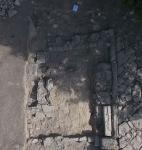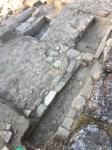Summary (English)
In agreement with the local administration of Cannara and the Archaeological Superintendency for Umbria, Perugia University, with the participation of students from other Italian and foreign universities, renewed excavations at Collemancio di Cannara, site of the Roman municipium of Urvinum Hortense.
Excavations took place in three distinct sectors: the first (trench 2, divided into three areas: a, b, and c) was on the summit plateau, immediately south of a large temple structure; the second sector (trench 1), the largest, was situated between the temple and a medieval church, and occupied an area of c. 210 m2. The third sector (trench 3) was opened to the north-east of the preceding one, on a nearby plateau.
A small cemetery area was uncovered in trench 1, characterised by well-made funerary structures, adjacent to the medieval church and probably associated with it. This confirmed the continued use of the site from the Roman to medieval period. A small channel was also identified in this area.
In trench 2, area A, a secondary road on a north-south alignment was uncovered. It lay on a tangent east of the temple structure, whose foundation trench (investigated in area C) seemed to have been damaged by excavations in the modern period (probably those undertaken by Giovanni Canelli Bizzozzero).
Trench 3 revealed a substantial wall on an east-west alignment, built in an unusual fashion. The upper course, built in large horizontally placed sandstone blocks, rested on small lumps and chips of sandstone placed in an irregular dry-stone construction.
All three sectors provided new evidence regarding the plan and urban development of Urvinum Hortense, and it is hoped to continue this research in 2018.
- Enrico Ciafardini - UNIPG
Director
- Grassigli Gian Luca - Dipartimento di Lettere. Lingue, Letterature e Civiltà antiche e moderne, Università degli Studi di Perugia.
Team
- Davide Squillace - UNIPG
- Rotondaro Francesco
Research Body
- Università degli Studi di Perugia
Funding Body
- Comune di Cannara






![Download [PDF]](/excavation/skins/fasti/images/results/download_sml.png)


